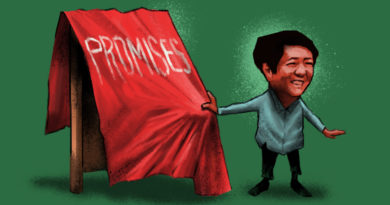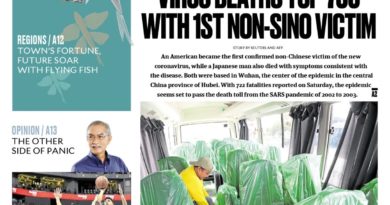BIZ-PROPERTY: BANGKOK – Design, location key to leasing apartments
Piya Residence, an 82-unit apartment development on Sukhumvit Soi 28 and 30, was completed in January this year and is already 30% leased within one month of completion. (Photo supplied by CBRE)
The single-ownership, expatriate-standard apartment market in Bangkok is performing well despite competition from rental units in condominiums, according to CBRE Thailand, the leading property consultancy.
This is despite the number of expatriates with work permits in Bangkok only growing slowly.
Most expatriates only want to live in a limited number of areas — Sukhumvit, Lumpini and Sathorn. Generally, they are only in Bangkok for two or three years and most want to rent, not purchase their residences.
The most popular choice is to rent an apartment or condominium because there are few houses or townhouses to rent in most expatriate areas. There is limited competition with serviced apartments, but only for studio and one-bedroom units, not larger units.
There are about 10,500 expatriate-standard apartments in the most popular areas and the current occupancy is over 97%. There are around 74,400 condominiums in the same most popular expatriate areas and CBRE Research estimates that about 30-40% of these units are owned by people who rent their units out.
Tenants prefer to rent apartments rather than units from individual owners in a condominium because they know they can go directly to building owners for repairs and requests.
In a condominium, the individual owner is responsible for the maintenance inside the unit and the building’s property manager is only responsible for the maintenance of the common areas. This means it can be difficult for tenants to get individual owners to repair items quickly.
Although many of the apartment buildings are more than 20 years old, generally both the common areas and unit decoration have been well maintained and renovated and are in much better condition than many condominium buildings of the same age.
CBRE’s research shows that there are approximately 400 apartment units in single-ownership buildings under construction in the most popular expatriate locations, but there are 22,200 condominium units under construction in these areas, 63% of which will be one-bedroom units.
The prospects for single-ownership apartments are good, especially for two- and three-bedroom units. Tenants prefer single-ownership buildings to condominiums and few new two-, three- and four-bedroom apartment and condominium units are being built.
One good example is Piya Residence, an 82-unit apartment development in two buildings on Sukhumvit Soi 28 and 30 that CBRE acts as its sole leasing agent and development consultant. The building was completed in January this year and is already 30% leased within one month of completion.
CBRE advised the developer of Piya Residence on all aspects of the design based on feedback from tenant’s comments from the over 400 expatriate residential leasing transactions CBRE closes each year.
“Location is not the only key to success, the unit layout, specification, furniture and facilities, along with the unit size, are critical to achieving the best rents and keeping an apartment fully occupied,” said Theerathorn Prapunpong, head of advisory and transaction services for residential leasing, CBRE Thailand.
Location continues to be important and the Phrom Phong area is one of the most popular locations for expatriate rentals in the Sukhumvit area.
It is important that any apartment developer or individual condominium owner looking to rent their unit understands the changing expatriate tenant requirements.
The amount of money that tenants spend each month on housing has not changed and is unlikely to increase in the near future. In a market with rising land and construction costs, this is a challenge for apartment developers.
Developers can make the units smaller but there is a limit on how small a unit can be before it becomes unattractive. The key is how to get the maximum functionality out of the smallest possible size, maximising both the rent per square metre and the attractiveness to tenants both in terms of use and affordability.
This is not easy and requires an understanding of exactly what tenants feel is important.
The decoration and furniture must appeal to a broad range of tastes and must be practical, durable and easy to clean and maintain.
Kitchens and bathrooms are unique selling points. Open kitchens are now acceptable but must have efficient extraction to remove any cooking smells. Bathrooms are very personal and tenants want a separate shower and bathtub in the master bathroom, which must look as good as those at a five-star hotel.
Facilities are important, many tenants will have families and will want a child-friendly swimming pool and playground.
Most expatriates will want to live in the same areas and will continue to prefer apartments rather than condominiums if given the choice of a unit of a similar size and quality in the same areas.
There is a future for apartment development focusing on expatriate tenants but developers need to match tenant’s requirements in order to achieve the highest rents and best occupancy rates.
Malin Phlernjai is an analyst, Research and Consulting, CBRE Thailand. She can be reached at [email protected] Facebook: CBRE.Thailand Twitter: @CBREThailand LinkedIn: CBRE Thailand website: www.cbre.co.th/ Published: 21 Mar 2018 at 12:13 / WRITER: Malin Phlernjai /
RELATED STORIES
Retiring in Thailand
All photographs, news, editorials, opinions, information, data, others have been taken from the Internet ..aseanews.net | [email protected] | For comments, Email to : Icarus d’ Greek | [email protected] | – Contributor









